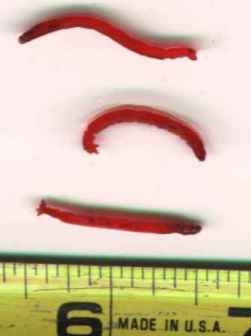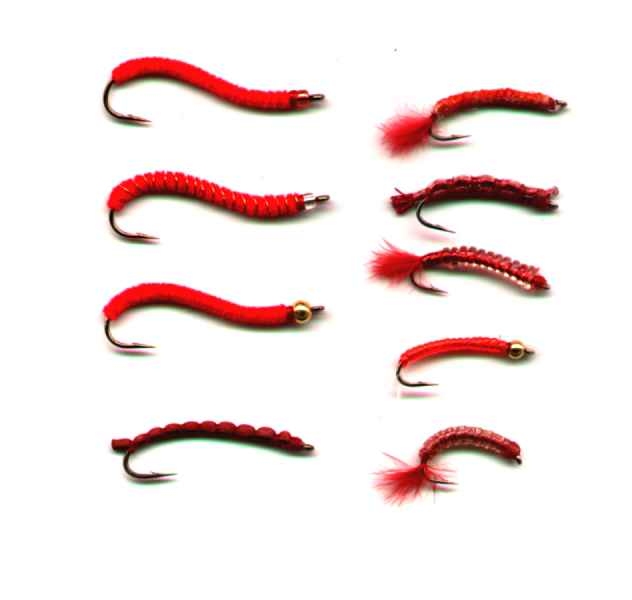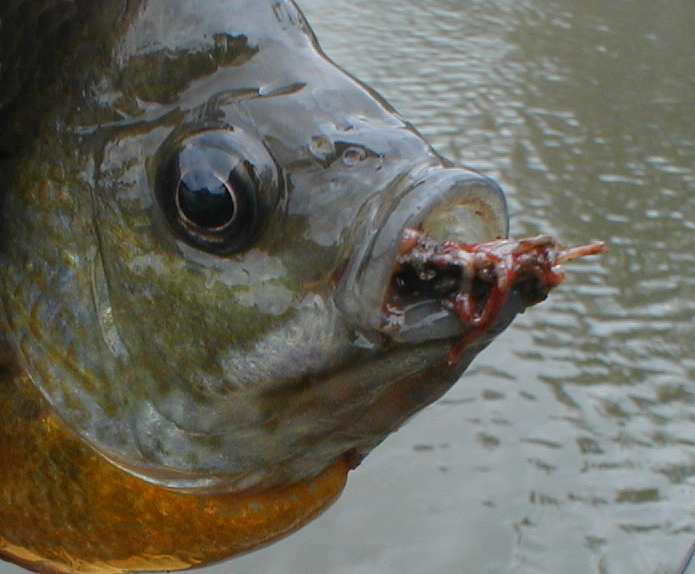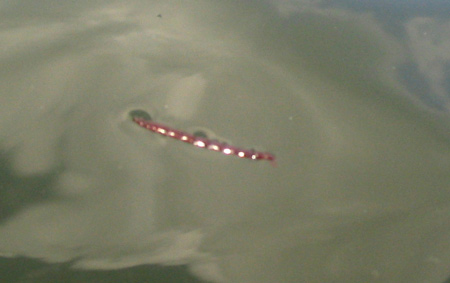|
 The
Bloodworm - The
Bloodworm -
Monster of the Deep
Some aquarium keepers know the bloodworm as
they are often sold as dried food. And some lucky still-water fly fishermen also
know them - they'll often put a fish pulling the end of your line.
My first experiences with them came when I caught
a fish down deep that occasionally be "spitting up" little tiny red
worms as I landed him. But I saw this only a few times and didn't attach much
significance. Then last year on a pond at Callaway Gardens, I found, on several
consecutive days, bloodworms floating in the surface film. These bloodworms were
big (see scan at left) - up to an inch and over in length and a beautiful,
bright, translucent red. What really got my attention, however, were the
vicious, slashing surface strikes I was also seeing. I took a few fish on
various dries and emergers, but had nothing in my box that looked like the huge
red worms. So began my quest for info on the bloodworm.
The bloodworm is actually the
larva or pupa of
a midge, but not the diminutive little fly we are accustomed to on trout
streams. Cliff Weber, an entomologist at Auburn University, tentatively
identified the bloodworm as Chironomus plumosus, a common large chironomid (midge) in ponds and
lakes. The identification was tentative, as exact categorization is almost
impossible. There are thousands of midge species, existing in almost every
country in the world. The bloodworms are a uniquely adapted species, able to
live in the oxygen-depleted depths of a pond. Their color and name comes from
the hemoglobin in their body, allowing them to store quantities of oxygen and
exist in deep, low-oxygen levels of the lake (the hypolimnion). For more details
on the bloodworm, visit
Ralph
Cutter's California School of Flyfishing or BC
Adventures (there's lots of good stuff on both these sites).
 In my research and correspondence with Auburn
University, I was unable to find a satisfactory explanation as to why these
larvae (not emergent pupae) where in the surface film. Under normal conditions,
they only leave the bottom of the lake to replenish oxygen levels and are not
known to come to the surface to do this. Possible theories included wind/wave
action, lake turnover, or uprooting by foraging fish or turtles - Auburn
entomologists gave little credence to either explanation. But, whatever....as
they say, don't look a gift horse in the mouth. So I went to the bench and
started tying big bloodworms. Since then, I have caught largemouth bass, various
sunfish, and stillwater trout with bloodworm imitations in several locations. In my research and correspondence with Auburn
University, I was unable to find a satisfactory explanation as to why these
larvae (not emergent pupae) where in the surface film. Under normal conditions,
they only leave the bottom of the lake to replenish oxygen levels and are not
known to come to the surface to do this. Possible theories included wind/wave
action, lake turnover, or uprooting by foraging fish or turtles - Auburn
entomologists gave little credence to either explanation. But, whatever....as
they say, don't look a gift horse in the mouth. So I went to the bench and
started tying big bloodworms. Since then, I have caught largemouth bass, various
sunfish, and stillwater trout with bloodworm imitations in several locations.
The photo
at left shows a big Callaway bluegill that has gorged itself on
bloodworms. He was trying to spit my fly as I brought him in - there
were literally dozenss of the larva in his mouth (and no telling how
many in his gut). When the fish tune in on the bloodworms, they do it
with a passion.
The flies are quite an easy tie - generally a bit
of red thread on a curved hook or a straight hook with the body extending into
the bend. Many use a bit of rabbit or marabou as a tail to extend the length and
add to the movement of the fly. Perhaps the Northwest is best known for
bloodworms in the deep stillwater lakes, and many of the patterns originate
there. If you tie an emerger, a small dark wingcase and white marabou or CDC gill
tufts can be added fore and aft. I tried lots of different ones (unable to
resist the urge to get a little fancy), but a bit of red floss or yarn on a hook
has been as successful as any.

Bloodworm fishing is perhaps, almost
simultaneously, the most boring and the most exciting fishing there is.
Bloodworms move thru the water in a very inefficient manner, wiggling a bit but
making little forward progress. Hence, their imitations are fished very slowly.
The norm is to cast the fly out on a sinking line or on a very long leader
(perhaps with a strike indicator), let
it sink as deep as the leader allows or to the bottom with a sinking line, and
then retrieve it at a very bare creep with lots of pauses. A 40' cast should
take up to several minutes to retrieve. This is so slow you could fall asleep in
your float tube - boring! But for some reason, when fish take the blood, they
absolutely slam it. I have never had a harder hit - numerous times I have broken
the fish off due to inattention, and on several occasions have almost lost my
rod. The fish seem to love the fly; maybe they are just cruising an area rapidly
and veer off when they see the worm, and take it on the run. Or, some say, the
fish sees the slow rise of the bloodworm, then swims above it and takes it on
the way down. Whatever the
reason, this has been my experience and one echoed by others who fish the
bloodworm. So don't let the slow retrieve lull you - or you may be swimming for
your rod.
|
|
|


times.